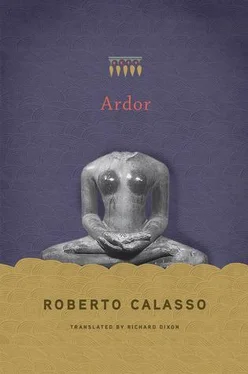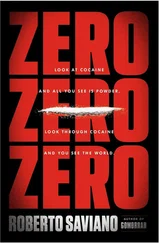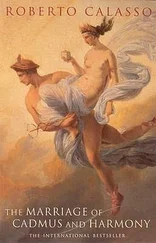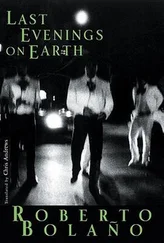The suspicion is confirmed and strengthened by a dark, vertiginous cosmogonic hymn in the Ṛgveda (10.129). This is how it starts, in Renou’s last translation: “Neither nonbeing existed then, nor being. / The space of the air did not exist, nor the firmament beyond. / What moved powerfully? Where? Under whose gaze? / Was it the water, unfathomably deep?” Sat and asat are not there, because “this universe was only an indistinct wave ( apraketáṃ salilám ).” But we cannot say that asat is not. Asat awaits only the “distinctive sign ( praketa )” that separates it from sat. In all this, where “darkness was hidden by darkness,” we could say that something existed called the “One” (as in Plotinus, but here it is something neuter, which becomes masculine in other passages). Who or what is this One coming before the gods? Another hymn describes it: “To the navel of the unborn, the One is fixed, / he on whom rest all creatures.” But the One must also emerge from the indistinct, where “it breathed by its own impetus, without there being breath.” What power can move it? Tapas , “ardor.” “Then, by the power of Ardor, the One was born / empty and clad in emptiness.” These verses are enough to show the inadequacy of the long-used Christianized translations of tapas ( penance , as favored by Eggeling, austerities, Kasteiung, ascèse ). Ardor is the only power that can dissolve the dark fixity of the beginning — and let the first distinction emerge: the One. Which appears immediately to have a disconcerting nature: it is “empty,” ābhu , and “clad in emptiness.” Puzzled, Renou notes: “‘empty’ ( ābhu ) or conversely ‘potential’ ( ābhū ).” Karl Geldner suggests more casually that the word refers to the “great void” of “original chaos.” But there is no trace in the Ṛgveda of a concept of chaos as something that “gapes open,” as implied by the Greek chaíno. And ābhu , “empty,” appears in only one other instance in the 1028 hymns, to mean “empty-handed.” Renou’s perplexity is therefore justified. At the beginning of the Veda, however much we look, we find never a “void” but something “full,” pūrṇa , or a “superabundance,” bhūman : something that overflows and, by overflowing, makes the world exist, since every life implies a boundless source of surplus. That One “clad in emptiness” must therefore be considered one of the more obscure points of the hymn.
The power that appears immediately after ardor — and almost as its immediate consequence — is kāma , “desire.” An unparalleled definition is given for it: “Desire, which was the first seed of the mind.” And here Renou translates manas as “consciousness,” bending the text in a direction that is implicit in it, because the original form of the mind — or at least that most dear to the Vedic seers — was the pure act of being conscious. And this is the point in the hymn where the poet-seers, kaváyaḥ , the first human characters, appear, not just as witnesses but as participants: “Inquiring in their heart, the poets succeeded in discovering / by their reflection the link between nonbeing and being ( sató bándhum ásati ).”
They are words that challenge, some centuries in advance, the Parmenidean prohibition on conceiving a passage from nonbeing to being. And they do so using the most precious word: bandhu , “nexus,” “bond,” “tie.” Thought, for the ṛṣis , was itself none other than a way of ascertaining and establishing bandhus. This was the beginning, and the culmination. Thought could offer nothing else. And it was clear that the first of these bandhus had to be the one between asat and sat. Here, once again, if the two words asat and sat mean “unmanifest” and “manifest”—and not “nonbeing” and “being,” which are too Greek — then the formula seems far clearer: because the manifest must continually draw upon the unmanifest, in the same way that the leg of a wild goose, of the haṃsa that will one day become a swan, must stay immersed in the wave. Otherwise the circulation of life would stop.
But the bandhu described above was only the threshold of the riddle. The three verses that follow are a breathtaking progression of doubts and flashes that it would be pointless trying to explain. The only clear thing is that we are entering an area of questions that do not have — and perhaps cannot have — an answer. First of all, the bandhu found by the poets inquiring into their heart is a “rope stretched across.” Across what, we are not told. In fact, it is followed by the questions “What was below? What was above?” And immediately there is a reference to dark powers, which Renou has translated as follows, with evident perplexity: “Spontaneous impetus,” “Gift of self.” They are the last appearances of something that one might try to affirm. What follows is the boldest and most surprising declaration on the impotence of thought. An unparalleled example of sublime sarcasm: “Who knows, in fact, who could declare here / from where this secondary creation [ visṛṣṭi , which presupposes the sṛṣṭi , “creation” before it] is born, from where it comes? / The gods [came] after, through the secondary creation of our [world]. / But who knows from where this emerged?” It is a compelling process, which makes the uncertainty even greater — and culminates in the last stanza: “This secondary creation, from where it emerged, / if it had been established or not, / he who oversees this [world] from the highest heavens, only he knows, or perhaps not even he.”
The Vedic seers were masters at raising the stakes, taking them beyond reach. Here the ṛṣi wanted to show how esoteric knowledge culminates in complete uncertainty. And that alone would have been a magnificent result. But for him that was not enough. The gods also had to be cloaked in the same uncertainty, as beings who were born too late, born also from the “secondary creation,” whose origin was unascertainable. The crucial step would be to extend the uncertainty — the suspicion of uncertainty and of ignorance — as far as the supreme, unnamed figure, “who oversees this [world]” from the highest point. No one had dared, no one would ever again dare, to deny the omniscience of this mysterious figure. But the ṛṣi does exactly that. Indeed, he leaves us in doubt using a more subtle cruelty, since, if he had claimed something with certainty about this figure, then he would already be going beyond what he was permitted to know. And so he suggests only the possibility of a supreme being, greater than the gods, who nevertheless may not know. And this is said as part of the Veda, which means Knowledge.
* * *
What happens after death? Silence, indistinctness of the elements. Then a voice is heard: “Come, here I am, your ātman. ” It is the divine Self, daiva ātmā , that speaks, it is that which has been constructed over a long time, laboriously, piece by piece, through the acts of sacrifice. It is another body that was waiting in the other world — and was meanwhile taking form, because “whatever oblation is sacrificed here, becomes his ātman in the other world.”
VIII. PERFECT WAKEFULNESS
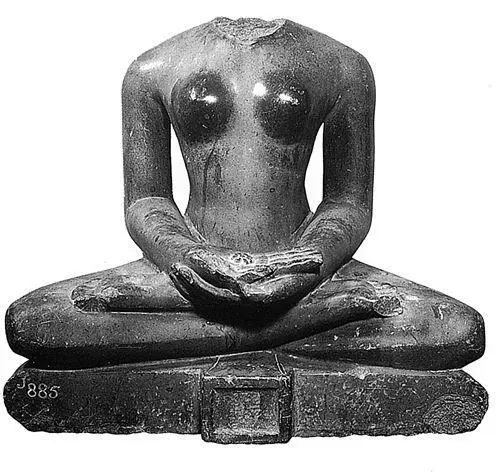
The wakefulness the Upaniṣads speak of (and the Ṛgveda before them) is a state opposed, not to sleep, but to another kind of wakefulness — inattentive, inert, automatic. Awakening means rousing oneself from that kind of wakefulness, as from a vapid dream. Philosophers have not regarded this swerve within the mind as worthy of consideration, but it became the focus of thought in one place and in one period: in India, in the time between the Veda and the Buddha — and then reverberated unremittingly through all the centuries thereafter.
Читать дальше
